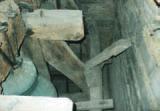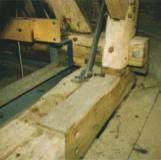Basic HTML Version




BCD Special Report on
Historic Churches
18th annual edition
19
how to control bells more effectively.
‘Change’ bell ringing (the ringing of
tuned bells in a pre-determined sequence)
developed during the 17th and 18th centuries
and spurred the modification and development
of stronger bell frames that could cope with
the forces generated by bells being swung
full-circle. Although there are many variations,
this group of timber frames, described as
‘long-headed’, form a box with top plates, sills,
foundation beams and braces to contain the
bells. Such frames were designed to hang the
bells in different alignments with lighter bells
counteracting the heavy ones. Full-circle ringing
meant that bells could be held motionless for a
second or two at the end of each full 360 degree
swing to allow the ringers to generate ‘changes’
by altering the sequence in which bells are rung.
There are a number of frame types.
These were first classified by bell historian
George Elphick in 1945 and more recently
updated by Christopher Pickford FSA.
Threats to timber bell frames
The greatest threats to the survival of this
resource of fine historic engineering and
craftsmanship are neglect, the re-hanging
of bells, and augmentation (increasing the
number of bells to an existing ring). Many
churches, particularly those in rural areas,
are at risk of redundancy. There are fewer
regular Sunday service bell ringers and even
fewer practice nights, when bells and their
frames and fittings are usually maintained.
Without maintenance, the timber bell frames
fall into disrepair, allowing decay to spread
and causing the bells to become unusable.
A broken louvre, leaking lead roof or
damaged downpipe can easily lead to the frame
becoming saturated. Ultimately, the timber
bell frame will rot with fungal decay or invite
Death watch beetle, which favours damp oak.
A structural failure in the tower will put a stop
to bell ringing, perhaps indefinitely. Inevitably,
the company of ringers will move to another
church or just give up their art leaving the bells
and historic timber frame to deteriorate.
The re-hanging of bells or augmentation
may mean altering an existing historic timber
bell frame or, at worst, replacing it with a steel
one. The desire to add further bells is driven by
an active and enthusiastic band of ringers who
want to develop their unique cultural heritage of
change ringing and preserve their craft. Often
in the past, little consideration has been given to
their significance and the impact that alteration
will have on the historic timber bell frame.
The process of change
Whereas alterations to secular listed buildings
require an application to the local authority
for consent, the principal denominations
in England, Scotland and Wales all operate
internal systems of control which exempt them
from this. Within the Church of England, for
example, no alterations, additions, removals
or repairs to a church, its fabric, ornaments
or furniture may be made without a ‘faculty’.
Where bells and their frames are concerned,
the DAC must be consulted, via their bell
advisors, as must the consultative bodies
including the CCCBR and English Heritage.
The following national amenity societies
would also be notified: the Society for the
Protection of Ancient Buildings (SPAB), the
Church Buildings Council (CBC), the Ancient
Monuments Society and the Council for
British Archaeology. With later structures
this could involve the Georgian Group, the
Victorian Society or the Twentieth Century
Society. Once the consultative bodies have
been advised, it is the diocesan chancellor who,
through the diocesan consistory court, issues
the faculty to allow the work to commence.
Objections to inappropriate works are heard
through the diocesan consistory court,
presided over by the diocesan chancellor.
Applications should be submitted with
supporting documentation including plans
and, for most denominations, two ‘statements’:
the statement of significance and the
statement of need, before recommendations
for management and change are made.
In order to identify the significance of a
bell frame, it is necessary to understand and
evaluate its fabric, construction, age, whether
it is the work of a single maker and whether
the frame bears any important inscriptions.
For example, there is a fine example of a signed
and dated frame at the Church of St Botolph,
Slapton, Northamptonshire (title illustration):
a locally made frame for two bells installed
in 1634 by Thomas Cowper of Woodend.
It is important to know how and why
the frame has changed over time and the
relationship with its setting in the tower,
including ancillary elements such as
clock mechanisms or carillons. It is then
necessary to consider, in the words of
English Heritage’s
Conservation Principles
:
• who values the place, and why they do so
• how those values relate to its fabric
• their relative importance
• whether associated objects
contribute to them
• the contribution made by the
setting and context of the place
• how the place compares with
others sharing similar values.
Clearly, the last remaining early medieval
timber bell frame in Dorset is of exceptional
national historic significance, as are the
detached timber bell cages at East Bergholt,
Suffolk and Wrabness, Essex. But would
a medieval timber frame which has been
altered over the centuries with only a
fragment of medieval work remaining
have the same significance? The question
is impossible to answer generically – each
case must be judged individually.
Regional differences can also contribute
to the significance of a particular bell
frame. Historically, timber was relatively
rare in areas such as Cornwall, compared
to Herefordshire, East Anglia and South
St Thomas a Becket, Hill Croome, Worcestershire:
A simple medieval king-posted frame with steep
braces with heavy transoms across the ends of the
three parallel pits. The transoms are stepped to allow
the bells to swing and give clearance for the clappers.
(Photo: Christopher Pickford)
St Mary, Pakenham, Suffolk: Timber oak plate
repaired with new scarf joint with compatible
material (Photo: Douglas Kent)
Medieval shorted-headed king post frame truss
Long-headed box frame, 18th–19th century (Diagrams: Christopher Pickford)

